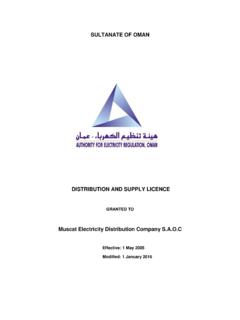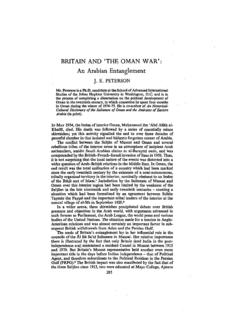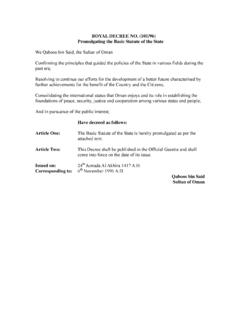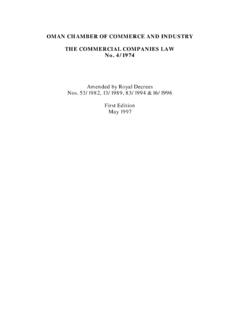Transcription of LAST ENGLISH april - AER OMAN
1 For Large Government,Commercialand Industrial CustomersCustomer GuideCostReflectiveTariffs2 IntroductionOn September 2016, the Council of Ministers had approved the introduction Cost of Reflective Tariff (CRT) for around 10,000 large Government, Commercial and Industrial customers who use more than 150,000 kilowatt hours (kWh) per year. That is less than %1 of all registered customers in accordance with the provisions of the Sector Law, this Cost Reflective Tariff (CRT) is designed to more accurately reflect the actual costs of providing a supply of electricity to large Government, Commercial and Industrial customers. Ministerial decision No. 3/2016 issued by the Public Authority for Electricity and Water on 29 December 2016 specified the component of the Cost Reflective Tariff, which includes production cost, transmission cost, distribution and supply cost. According to the latter decision, the Cost Reflective Tariff is applied with effect from 1 January 2017 to all eligible customers.
2 This Guide describes the key features of the new tariff arrangements for large Government, Commercial and Industrial customers and is designed to help those affected to better understand the new arrangements. It is important to recognize that, in common with best practice internationally, the new tariff incorporates variable seasonal and, at times, daily prices. The new tariff structure also includes a combination of various types of tariffs, including energy (bz/kWh), demand (RO/MW) and standing (RO/customer account) charges. Each customer s bill will reflect their unique pattern of consumption and the demands that they make on the electricity production, transmission, distribution and supply system. As the new tariff is designed to reflect the full costs of supplying electricity, without Government subsidy, it is likely that some customers will receive bills that are higher than those they previously paid. Bills may also be higher if large amounts of electricity are consumed in the peak summer periods.
3 Overall, it is expected that the new arrangements will provide customers with incentives to more carefully manage their consumption through energy efficiency measures and by shifting as much consumption as possible away from peak periods. 3 Key featuresAs described above, the new tariff is designed to reflect the actual costs of supplying electricity. As with many other industrial sectors these are: production costs (in the Omani electricity sector these are recovered through the Bulk Supply Tariff ) transport costs (in the electricity sector we separate this into the high voltage national transmission networks and the low voltage local distribution networks these are described separately) andretail costs (in the electricity sector this is usually referred to as supply). In oman , as elsewhere, production of sufficient electricity to meet the nation s demand is arranged through contracts with power production facilities (typically gas burning power generating stations and potentially, in the future, renewables capacity).
4 The costs of meeting oman s electricity demand vary according to how much production capacity must run at any one time. These variable costs are reflected in the new tariff through an element known as BSt (Bulk Supply tariff).The BST comprises of a schedule of charges (in bz/kWh) that vary by hour, day and month to reflect the cost of production at various periods. Bulk Supplies made to customers connected to the main interconnected system (MIS) those supplied by Muscat Electricity Distribution Company, Majan Electricity Company or Mazoon Electricity Company shall be charged in four rate bands, based on the day of the week and the time of day that electricity is taken. Production4 Bulk Supply Tariff - MIS*Bulk Supply Tariff Rate Bands- MIS*Table 2 :Table 1 :WeekendDay-PeakWeekdayDay-PeakNight-Pea kOff-Peak12121212 January March14141414 April39672617 May July19262115 August - September14141414 October12121212 Nov DecThis also includes those customers of the Rural Areas Electricity Company not connected to the Dhofar power system.
5 The rate bands are defined in Table 1 below: Days & TimesRate BandAll days, to and to days, to (following day)Night-PeakSunday to Thursday, to to Saturday, to Day-PeakThe rates (in Rial Omani per MWH) applicable for Bulk Supplies in each rate band during each month during 2017 shall be as set out in Table 2 below: 5 For those parts of oman connected to the Dhofar power system (and suppliedby the Dhofar Power Company) the charges are slightly different,reflecting differences in underlying demand. Bulk Supplies made to customers Table 3 :Bulk Supply Tariff - Dhofar Power System*Off-Peak Nightmid-PeakOff-Peak MorningOn-PeakAll DaysWeekendWeekdayAll DaysWeekendWeekday121212121212 January March272528193333 April272542283353 May June131313131313 July August131317131317 Sept Oct121212121212 Nov DecDays & TimesRate BandSunday to Thursday, to and to WeekdayFriday to Saturday, to and to WeekendAll days, to Off-Peak MorningSunday to Thursday, to WeekdayFriday to Saturday, to WeekendAll days, to NightThe rates (in Rial Omani per MWH) applicable for Bulk Supplies in each rate band during each month during 2017 shall be as set out in Table 4 below.
6 It can be seen for, example, that compared with the BST for the MIS, time of day charges take effect from april , whilst July and August prices are much Supply Tariff Rate Bands- Dhofar Power System*Table 4 :*Source of Tables 1-4: PWP Electricity Bulk Supply Tariff Leaflet connected to Dhofar Power System (DPC) shall be charged in six rate bands, based on the day of the week and the time of day that electricity is taken. The rate bands are defined in Table 3 below: 6 Charges for subsequent calendar years will be revised based upon changes in underlying production costs and will be published for the next calendar year ahead on the AER website in a revised Statement of CRT Charges each November. Where required, new metering arrangements will be implemented in order to ensure that consumption in each charging period can be accurately measured. If necessary your electricity supplier will be in touch with you about transmission and distribution systems lose a certain amount of the electrical energy input to the system in the process of transmitting and distributing that energy to customers (known as technical losses).
7 These will be recovered through the transmission (T) and distribution(D) charges described below. These arrangements provide large Government, Commercial and Industrial customers with incentives to more carefully manage their consumption through energy efficiency measures and, in particular, to limit their consumption during peak periods of the year and during peak hours of the day. TransmissionThe costs of the high voltage electricity transmission networks largely reflect the size (capacity) of the transmission system. Large Government, Industrial and Commercial customers will therefore be charged on the basis of the demands they place on the capacity of the system, which equates to their contribution to overall system demand. In line with international practice this will be measured at the time of the peak system demand and does not therefore necessarily coincide with each customer s peak demand. New metering arrangements will ensure this can beaccurately measured for each affected customer if the customer s existing metering arrangements cannot accurately record hourly consumption.
8 7 These costs are reflected in the new cost-reflective tariff through transmission use of system charges (T). The level of charge for the T element in 2017 will be RO 12,600 per megawatt (mW) equating to RO per kilowatt (kW) and applies equally to customers throughout the country. This will be recalculated each year based on the allowed revenues of the oman Electricity Transmission Company (OETC) system and published in November of each year for the calendar year ahead in the revised Statement of CRT ChargesAlthough the charge represents only the consumption during the peak hour of system consumption (which is likely to be in May, June or July for both the MIS and the Dhofar transmission system) the charge will be recovered in monthly bills and will not simply be added to the bill for the month in which the system peak demand occurs. As system peak demand can only be known after the event the following method will be applied in order recover the T element from large Government, Commercial and Industrial customers.
9 Each customer s consumption at the time of peak system demand will be estimated on the basis of previous consumption records; the total estimated charge for each customer will be divided by 12 and a monthly charge included on each bill; andafter peak system demand for the year is known the T element will be recalculated to reflect actual consumption at that time and future bills adjusted accordingly. These arrangements provide large Government, Commercial andIndustrial customers with incentives to carefully manage their consumption during peak SupplyDistribution costs represent charges for investment in and operation of medium and low voltage electricity networks. These costs are less dependent upon peak day consumption and, in line with international practice, charges will be averaged and recovered on the basis of a charge for each kilowatt hour (kWh) consumed. These costs are reflected in the new cost-reflective tariff through distribution use of system charges (D).
10 The level of charge for the D element in 2017 will be RO 0,007 (7bz) per kilowatt hour (kWh). This will be recalculated each year based on the average of the allowed revenues of Muscat Electricity Distribution Company, Majan Electricity Company, Mazoon Electricity Company and Dhofar Power Company and will be published in November of each year for the calendar year ahead in the revised Statement of CRT Charges. Even though it is calculated on the basis of the allowed revenues of Muscat, Majan, Mazoon and Dhofar it will be applied equally to all distribution connected customers in oman , including customers of the Rural Areas Electricity Company. Customers directly connected to the transmission network (at 132kV) will not be required to pay distribution system costs reflect the costs of retail operations, including meter reading, billing, cash collection, query management and customer communications. As such costs do not vary significantly on the basis of consumption they will be calculated on an averaged basis.









